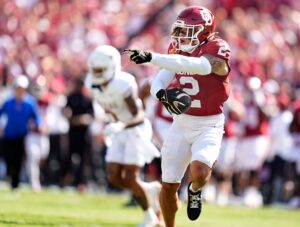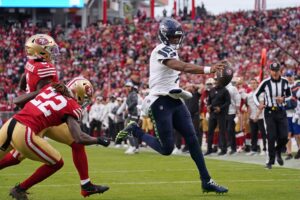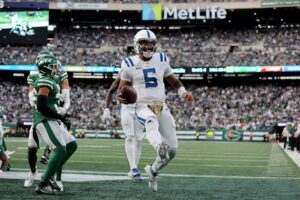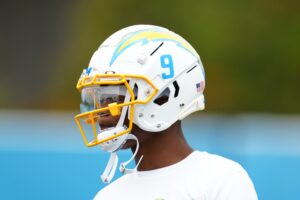The night before Super Bowl LIII we’ll find out which NFL greats will get busted in the Pro Football Hall of Fame in 2019.
On Saturday, presentations will be made in an Atlanta hotel room on behalf of one Senior Committee candidate, two contributor candidates, and 15 Modern-Era finalists. Johnny Robinson, the Senior Committee candidate, and Pat Bowlen and Gil Brandt, the Contributor candidates, will be voted on individually. Each will need to receive at least 80 percent “yes” votes to be selected for enshrinement.
Who Should Get Busted In the Pro Football Hall of Fame This Year?
As for the 15 Modern-Era candidates, their number is reduced to 10, then to the final five. Those five remaining candidates then get yes/no votes. Each of the final five that gets 80 percent “yes” votes are selected for enshrinement.
What the process adds up to is that there can be as few as five selected and as many as eight, if the Contributor and Senior candidates receive yes votes.
There are five first-time Modern-Era finalists in the group this year. Three of those players have strong cases to be enshrined in 2019. That leaves the other 12 Modern-Era finalists fighting for the final two available slots. The following is how it should all play out.
The Opening Cuts
Tom Flores – Head Coach (Oakland/Los Angeles Raiders 1979-1987; Seattle Seahawks 1992-1994)
First Time Finalist
Positives: In 1980, Tom Flores was head coach when the Oakland Raiders became the first team to win the Super Bowl as a wild card. Flores twice coached the Raiders to Super Bowl victories. He led the Raiders to 11 wins or more four times and was named AFC Coach of the Year in 1982.
Negatives: Flores’ teams finished under .500 in five of his 12 seasons as a head coach. He also finished his coaching career with a rough three-year stretch at the helm of the Seattle Seahawks.
Verdict: There are Pro Football Hall of Fame arguments that can be made for too many of the player finalists. That’s always a bad thing for a coaching nominee. Flores wasn’t one of the top coaches in the game during his tenure, let alone of all time so he’s going to be one of the first out of the room.
John Lynch – Safety (Tampa Bay Buccaneers 1993-2003; Denver Broncos 2004-2007) First Team All-Pro – 2; Second Team All-Pro – 2; Pro Bowls – 9
Pro Football Hall of Fame Finalist: 2014, 2015, 2016, 2017, 2018
Positives: John Lynch had the reputation as one of the hardest hitting safeties in the NFL during his career. He was also one of the leaders of the defense that propelled the 2002 Tampa Bay Buccaneers to a Super Bowl title.
Negatives: Lynch didn’t establish himself as Tampa Bay’s starting strong safety until his fourth season. He failed to beat out Marty Carter his first two seasons and shared starting duties with Barney Bussey in his third year. Also, for a safety, Lynch doesn’t have the career tackle numbers that rank him among the NFL’s greats.
Verdict: Lynch’s career as a broadcaster and now as general manager of the San Francisco 49ers has kept his name alive with the selection committee. Lynch is also the fifth best defensive back of the five that are Modern-Era finalists. That’s why he’ll be eliminated early.
Isaac Bruce – Wide Receiver (Los Angeles/St. Louis Rams 1994-2007; San Francisco 49ers 2008-2009) Second Team All-Pro – 1; Pro Bowls – 4
Pro Football Hall of Fame Finalist: 2017, 2018
Positives: Isaac Bruce topped 1,000 receiving yards eight times in his career. He led the NFL in receiving yards in 1996 with 1,338. Bruce was second to only Jerry Rice on the career receiving yards list at the time of his retirement. He recorded six catches for 162 yards including a 73-yard, game-winning touchdown catch in the St. Louis Rams 23-16 Super Bowl XXXIV victory over the Tennessee Titans.
Negatives: Bruce only led the NFL in receiving yards once. He was never named as a First Team All-Pro and only appeared in four Pro Bowls in his 16-year career.
Verdict: A measuring stick for belonging in the Hall of Fame is, was he the best player in the game during his era. While Bruce put together impressive career numbers he wasn’t even the best receiver on his team during his era (see Torry Holt). The selection committee can keep putting Bruce on the finalist list but on this list, he’ll always have to settle for the Hall of Very Good.
Richard Seymour – Defensive End/Defensive Tackle (New England Patriots 2001-2008; Oakland Raiders 2009-2012) First Team All-Pro 3; Second Team All-Pro 2; Pro Bowls 7
First Time Finalist
Positives: Richard Seymour was the anchor of the New England Patriots defense at the beginning of the franchise’s dynasty years. He was a versatile defensive lineman, run stuffer, strong pass rusher and could also drop into coverage. He was credited with 10 passes defended in 2003 and eight in 2006.
Seymour played in four AFC championship games and four Super Bowls including victories in Super Bowls XXXVI, XXXVIII and XXXIX. He was named to the NFL’s All-Decade Team of the 2000s.
Negatives: Versatility can work against a player’s candidacy. Lack of big counting stat numbers, sacks, forced fumbles and tackles will hurt Seymour’ss argument, at least in his first time in the room.
Verdict: This is Seymour’s first year as a finalist and three of the other first year candidates will be getting a lot more attention from the Selection Committee. The positive for Seymour is he’s fought his way into the final room and will have had a case made for him for the first time. He will be back.
Don Coryell – Head Coach (St. Louis Cardinals 1973-1977; San Diego Chargers 1978-1986)
Pro Football Hall of Fame Finalist: 2010, 2015, 2016, 2017
Positives: Don Coryell was one of the greatest offensive innovators in NFL history. “Air Coryell” still sets the standard for vertical passing offenses. He was also one of the first to involve the tight end as a regular component of the passing game. The three-year period with the St. Louis Cardinals from 1974 to 1976 was the most successful in franchise history until Bruce Arians‘ time as head coach. Jim Hart became the franchise passing leader and made the only four Pro Bowl appearances of his career while playing under Coryell.
In San Diego, Coryell took over a losing franchise and turned it into an AFC powerhouse. The San Diego Chargers led the NFL in passing yards six straight seasons. Coryell is the man Dan Fouts credits for his Hall of Fame career.
When Coryell retired he was 13th on the all-time head coaching wins list. He was named NFL Coach of the Year in 1974 and AFC Coach of the Year in 1979.
Negatives: Coryell’s overall record in the playoffs is 3-6. In six playoff appearances, his teams only went to two conference championship games and no Super Bowls.
Verdict: Coryell’s win total when he retired was among the best in NFL history. He’s 39th today but he didn’t have the benefit of coaching a 16-game season until he got to San Diego. Coryell could go in as a coach but he’s fighting too many strong player candidates this year. If Coryell would ever be nominated as a Contributor instead of coach his bust would be displayed among the honored immediately.
Honorable Mentions
The following players could go into the Pro Football Hall of Fame in 2019 depending on how conversations progress among the Selection Committee.
This is the start of the wild card category. There are too many worthy Hall of Fame candidates to vote for and not enough slots for them to be selected for 2019 enshrinement.
Steve Hutchinson – Guard (Seattle Seahawks 2001-2005; Minnesota Vikings 2006-2011) First Team All-Pro – 5; Second Team All-Pro 2; Pro Bowls – 7
Pro Football Hall of Fame Finalist: 2018
Positives: Steve Hutchinson paved the way for NFL Offensive Player of the Year Shaun Alexander to gain a Seattle Seahawks record 1,880 yards and NFL record 28 touchdowns in 2005. In 2008, Hutchinson helped clear the way for Adrian Peterson to become first Minnesota Vikings player to lead the NFL in rushing.
Hutchinson was named to the NFL’s All-Rookie team in 2001, was named the NFL Alumni offensive lineman of the year twice and was selected to the NFL’s All-Decade Team of the 2000’s. Hutchinson also played in two NFC Championship Games and one Super Bowl.
Negative: Interior linemen don’t receive much love from the Selection Committee. Only three Modern-Era interior linemen have been inducted in the last 10 years.
Verdict: The choice of which interior lineman will be honored in 2019 is going to be between Hutchinson, Alan Faneca and Kevin Mawae. Will the selection committee take two interior linemen in one year? Highly unlikely considering the committee’s voting record. It’s widely accepted that all three of the interior linemen on the finalist list are Hall of Fame worthy. If not Faneca or Mawae then Hutchinson will be voted in this year.
Kevin Mawae – Center (Seattle Seahawks 1994-1997; New York Jets 1998-2005; Tennessee Titans 2006-2009) First Team All-Pro – 3; Second Team All-Pro – 4; Pro Bowls – 8
Pro Football Hall of Fame Finalist: 2017, 2018
Positives: Kevin Mawae started 238 of the 241 games he played in over his 16-year NFL career. He blocked for a 1,000-yard rusher in 13 of his 16 seasons. Mawae anchored the offensive line that opened the holes for the seven 1,000-yard seasons by Hall of Fame running back Curtis Martin.
The New York Jets made the playoffs four times and one AFC Championship Game during Mawae’s career. He was also named NFL Alumni Offensive Lineman of the Year once.
Negative: You think it’s tough getting into the Hall of Fame as a guard, try it as a center.
Verdict: You can’t have a strong offensive line without a top center and Mawae was that without a doubt. Bill Parcells said of him, “Kevin’s the best center I ever had by far and he’s one of the best I’ve ever seen as well.” For Mawae, he will be fitted for a Hall of Fame gold jacket. It’s just a matter of when.
Edgerrin James – Running Back (Indianapolis Colts 1999-2005; Arizona Cardinals 2006-2008; Seattle Seahawks 2009) First Team All-Pro – 1; Second Team All-Pro – 2; Pro Bowls – 4
Pro Football Hall of Fame Finalist: 2016, 2018
Positives: Edgerrin James crashed the NFL party in a big way his rookie season with the Indianapolis Colts. In 1999, he led the NFL in carries with 369, rushing yards with 1,553 and added 62 receptions to lead the league with 431 touches and 17 all-purpose touchdowns. For that effort, he was named the 1999 Offensive Rookie of the Year. He followed that up in 2000 by leading the league in rushing again and also topping the NFL with 2,303 yards from scrimmage.
James was as dangerous a receiving weapon as he was as a runner, catching 75 percent of his targets during his 11-season career. James was also outstanding at blocking and picking up blitzes.
Edge was tenth on the all-time rushing list, 16th on the rushing touchdowns list and 20th on the yards from scrimmage list when he retired. James was selected to NFL’s All-Decade Team of 2000s.
Negatives: James’ yards per carry average of 4.0 means he needed the ball in his hands a lot to accumulate the numbers he retired with. He had over 300 carries seven times in his 11-year career, over 400 touches in his first two seasons. The heavy workload later affected his ability to accelerate past tacklers and his ability to stay on the field consistently. James only played a full 16-game schedule in five of his 11 seasons in the league.
Verdict: James has all of the qualifications to be enshrined. What is going to continue to hurt his candidacy is his yards per carry average. James will eventually be modeling a gold jacket in Canton but likely not this year with the backlog of defensive backs and offensive linemen lined up against him.
Ty Law – Cornerback (New England Patriots 1995-2004; New York Jets 2005, 2008; Kansas City Chiefs 2006-2007; Denver Broncos 2009) First Team All-Pro – 2; Pro Bowls – 5
Pro Football Hall of Fame Finalist: 2017, 2018
Positives: Ty Law was an important part of New England’s early dynasty years. He led the NFL with nine interceptions in 1998, returning them for 133 yards and one touchdown. Law also led the league with 10 interceptions in 2005, his first season with the Jets.
In 2003, Law intercepted six passes and led the league with 23 passes defended. In the playoffs that season he intercepted three passes and was credited with four passes defended during the Patriots run to victory in Super Bowl XXXVIII.
Overall, Law was a starting left cornerback in four AFC Championship Games and three Super Bowls. He was also selected to the NFL’s All-Decade Team of the 2000’s.
Negative: Though not his fault, he bounced between three teams in the final five years of his career.
Verdict: Champ Bailey has the better numbers in passes defended and tackles with only one fewer career interception. The prediction here is that Bailey will win the battle of the cornerbacks this year but Law’s time is coming soon.
Steve Atwater – Safety (Denver Broncos 1989-1998, New York Jets 1999) First Team All-Pro – 2; Second Team All-Pro – 2; Pro Bowls – 8
Pro Football Hall of Fame Finalist: 2016
Positives: Steve Atwater was one of the most punishing safeties to play the game. He has more career combined tackles than Brian Dawkins, who was enshrined last year. Atwater was also an accomplished ball-hawk with multiple interceptions in all but three seasons of his career.
In 1989, Atwater’s rookie season, the Denver Broncos defense led the NFL in fewest points allowed. Atwater snared three interceptions that season and recorded 129 combined tackles. He bested that with 173 combined tackles in 1990.
Atwater started at free safety in four AFC championship games and three Super Bowls. He was also named to the NFL’s All-Decade Team of the 1990s.
Negatives: None, Atwater was everything a safety should be.
Verdict: If Ed Reed weren’t a certified lock to be inducted this year then Atwater would have a much better chance. Reed has come out and said, “I pray to God that Steve Atwater gets in. If I get in and he doesn’t get in, I would rather give my spot to him.” It would be wonderful to see Reed and Atwater go in together but it’s unlikely. Don’t be mistaken though. “The Smiling Assassin” will eventually get to Canton.
The Following Should Get Busted In 2019
Pat Bowlen – Contributor (Owner – Denver Broncos)
Positives: Why has it taken so long for Pat Bowlen to finally reach this point? The Broncos have been one of the most successful franchises in the NFL since he bought the team in 1984. During Bowlen’s time as owner, the Broncos have made 18 postseason appearances, won 13 division titles, seven conference championships and three Super Bowls (XXXII, XXXIII and 50).
Pat Bowlen was part of numerous NFL committees over the course of his career and participated in many key labor and television rights negotiations.
Negative: Bowlen had to relinquish control of the team in 2014 due to complications from Alzheimer’s disease.
Verdict: The above negative is because Bowlen should have been inducted long before an insidious disease robbed him of the memories of a lifetime of accomplishments. He deserves to revel in this honor and won’t be able to.
Gil Brandt – Contributor (Dallas Cowboys 1960-1988, National Football League 1995 to Present)
Positives: Gil Brandt, along with Tex Schramm and Tom Landry, was responsible for building the Dallas Cowboys into one of the most dominant franchises in NFL history for over two decades. During Brandt’s time as vice president of player personnel, he developed scouting and player grading systems that today are used league-wide. He also pioneered the use of computers for player evaluation.
Brandt brought in the players that won 13 division titles, six conference championships and two Super Bowls.
Negative: Football fans nationwide had to put up with over 25 years of hearing the Cowboys referred to as “America’s Team.”
Verdict: The only issue with Gil Brandt being inducted into the Hall of Fame in 2019 is that it shouldn’t have taken near as long for it to happen.
Senior Committee – Johnny Robinson – Safety (Dallas Texans/Kansas City Chiefs 1960-1971) All-AFL – 5; First Team All-Pro – 1; AFL All-Star – 6; Pro Bowls – 1
Pro Football Hall of Fame Finalist: 1980, 1981, 1982, 1983, 1985, 1986
Positives: After starting his first two seasons as a running back, Johnny Robinson became one of the top safeties in the American Football League. He led the AFL in interceptions with 10 in 1966 and topped the post-merger NFL with 10 in 1970. Robinson played in three AFL Championship Games.
He played a big part in the Dallas Texans 1962 AFL Championship Game double-overtime victory over the Houston Oilers with two interceptions for 57 yards. Robinson also started for the Kansas City Chiefs in two Super Bowls. In Kansas City’s 23-7 Super Bowl IV win over the Vikings, Robinson recorded two tackles, one fumble recovery and one interception.
Negative: Played all but two seasons of his career before the AFL/NFL merger was completed in 1970.
Verdict: During his Modern-Era eligibility period, Robinson was the victim of bias against players who played a majority of their career in the AFL. The last time a senior committee nominee failed to gain election was Claude Humphrey in 2009, and Humphrey made it on his second attempt in 2014. Robinson will keep the string of senior nominee success going.
Tony Boselli – Tackle (Jacksonville Jaguars 1995-2001) First Team All-Pro – 3; Pro Bowls – 5
Pro Football Hall of Fame Finalist: 2017, 2018
Positives: Tony Boselli’s career was cut short due to injury but he was always considered an elite left tackle. He anchored an offensive line that helped the Jacksonville Jaguars to four straight playoff appearances and one AFC Championship Game. Boselli was also selected to the NFL’s All-Decade Team of the 1990s despite only playing in half of the decade.
Negatives: Boselli suffered a severe shoulder injury in 2001 that ultimately ended his career. Still, Boselli was clearly head and shoulders above the competition when he was on the field.
Verdict: Boselli will get the Gale Sayers/Terrell Davis injury-shortened career exception this year. He’s been in the final 10 two years in a row as a Hall of Fame finalist and it’s only a small step from that point to finally getting over the top with the voters. Also, Boselli is no longer splitting position votes with Joe Jacoby who fell short last year in his final election as a modern-era candidate at tackle.
Alan Faneca – Guard (Pittsburgh Steelers 1998-2007; New York Jets 2008-2009; Arizona Cardinals 2010) First Team All-Pro – 6; Second Team All-Pro – 2; Pro Bowls – 9
Pro Football Hall of Fame Finalist: 2016, 2017, 2018
Positives: Alan Faneca played in all but one game in his 13-year career and he was a dominating run blocker. Teams with Faneca at guard finished in the top 10 in rushing 11 times. He blocked for nine 1,000-yard rushers and five 3,000-yard passers. Faneca was also rarely flagged for penalties in his 13-year career.
Faneca started at left guard in 14 career playoff games including four AFC championship games and Super Bowl XL. He was also named the NFL Alumni offensive lineman of the year twice and to the NFL’s All-Decade Team of the 2000s.
Negatives: Faneca played at one of the toughest positions to receive recognition for.
Verdict: Jerome Bettis said, “I wouldn’t be in the Hall of Fame without Alan Faneca.” That’s an impressive endorsement. Faneca has the most durability and more end of season honors than the other two interior line candidates. That’s why he gets in this year.
Champ Bailey – Cornerback (Washington Redskins 1999-2003, Denver Broncos 2004-2013) First Team All-Pro – 3; Second Team All-Pro – 4; Pro Bowls – 12
First Time Finalist
Positives: Champ Bailey is the all-time leader in passes defended in a career with 203 according to Pro Football Reference. He led the NFL in 2002 with 24 passes defended. Bailey recorded multiple interceptions in all but two of his 15-season career. He led the league in interceptions in 2006 with 10 and 162 return yards. Bailey intercepted 18 total passes in 2005 and 2006. He was the leading interceptor on the Broncos in five seasons.
Bailey started at left cornerback in two AFC championship games and Super Bowl XLVIII. He was also named a member of the NFL’s All-Decade Team of the 2000’s
Negative: In 11 playoff games, Bailey only intercepted two passes.
Verdict: Bailey was one of the best man coverage cornerbacks in the league during his career. He has outstanding career and single-season marks despite quarterbacks regularly throwing away from his coverage. Including Bailey as part of the Pro Football Hall of Fame class of 2019 will not be a difficult case to make.
Ed Reed – Safety (Baltimore Ravens 2002-2012; Houston Texans/New York Jets 2013) First Team All-Pro 5; Second Team All-Pro 3; Pro Bowls 9
First Time Finalist
Positives: Ed Reed is seventh on the career interceptions list with 64 and first all-time in interception return yards with 1,590. Reed’s 358 interception yards returned in 2004 is second highest on the single-season list. He led the NFL in interceptions three times and in interception return yards twice.
In postseason play, Reed is tied for first in career interceptions, fourth in interception return yards and has one interception return for a touchdown. He recorded five tackles, one interception and one pass defended in the Ravens’ Super Bowl XLVII win
Reed was named a member of the NFL’s All-Decade Team of the 2000s and was honored as the NFL’s Defensive Player of the Year in 2004.
Negatives: Reed only participated in the 40-yard dash at his Combine in 2002. Did he decide he was too good to participate in the other drills? Turns out, he was. Also, in 30 career punt returns he only took one back for a touchdown.
Verdict: Reed has career numbers that stand with Hall of Fame safeties who were able to get away with a lot more in coverage during their eras. Normally safeties have problems getting in, especially as a first time finalist. That won’t be a problem here.
Tony Gonzalez – Tight End (Kansas City Chiefs 1997-2008; Atlanta Falcons 2009-2013) First Team All-Pro 6; Second Team All-Pro 4; Pro Bowls 14
First Time Finalist
Positives: Tony Gonzalez was second to Jerry Rice in career receptions when he retired and still holds that position today. He is also sixth on the all-time receiving yards list and eighth on the receiving touchdowns list. Gonzalez maintained a streak of catching a pass in 211 straight games, still a record for a tight end. He owns three spots on the top ten single-season tight end reception totals list. Finally, Gonzalez was selected to the NFL’s All-Decade Team of 2000’s
Negative: Gonzalez acted in the movie “xXx: Return of Xander Cage.”
Verdict: When Gonzalez retired, he was considered not just the greatest tight end of his time but one of the greatest tight ends to ever play the game. He has career pass catching numbers that rival the Hall of Fame wide receivers.
If Gonzalez isn’t a lock to be inducted in 2019 then there’s no such thing. He’s going to look sharp in his new gold jacket.






